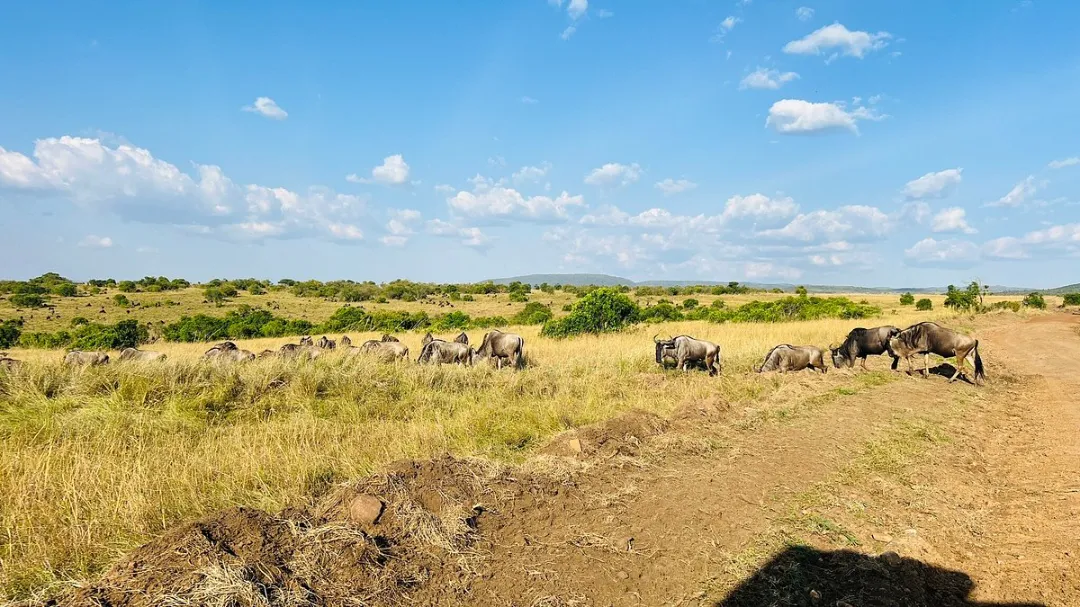Masai People: Culture and Traditions
The Masai people of Kenya and Tanzania maintain a nomadic lifestyle that revolves around cattle herding. This article examines their unique traditions, historical background, and modern-day challenges.
Key Takeaways
The Maasai people have a rich cultural heritage characterized by unique customs, dialects, and a strong historical background of resilience against external pressures.
Traditional Masai practices, including pastoralism and community roles defined by gender, are central to their identity, despite challenges posed by modernity and land dispossession.
The Maasai face significant contemporary issues such as eviction from ancestral lands due to tourism and conservation policies, prompting adaptations in their lifestyle while striving to preserve their cultural traditions.
Table of Contents
Historical Background of the Maasai People
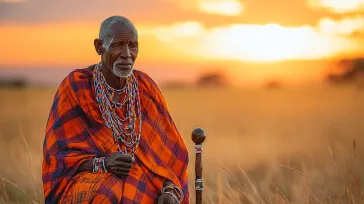
The Maasai, historically a nomadic people and a Nilotic ethnic group, embarked on a significant migration from South Sudan to their current territories, including southern Kenya. This migration saw them adopt certain customs from neighboring Cushitic-speaking communities, enriching their social organization and vocabulary. As they expanded into East Africa, the Maasai often displaced other tribes, establishing themselves as a dominant force in the region.
Comprising twenty-two distinct sub-groups, each with unique customs and dialects, the Maasai community is a mosaic of cultural diversity. Known for their fierce protection of their community from external threats, the Maasai resisted slavery and maintained their autonomy. This historical backdrop sets the stage for understanding the depth and resilience of Maasai traditions and culture.
Settlement and Territory Expansion
The Maasai territory reached its zenith in the mid-19th century, covering vast regions of the Great Rift Valley from Mount Marsabit to Dodoma. The Maasai began their expansion into northern Tanzania, establishing a significant presence in the region. However, the arrival of European settlers and the subsequent establishment of national parks like Maasai Mara and Amboseli disrupted their traditional nomadic lifestyle. The ‘Emutai’ period from 1883 to 1902 marked a time of significant hardship for the Maasai, with disease and drought leading to drastic population declines.
The pressure from conservation policies in areas like Amboseli often overlooked the Maasai’s historical land rights and traditional practices. Despite these challenges, the Maasai’s adaptation and resilience have been crucial in maintaining their cultural identity amidst changing landscapes.
Traditional Maasai People’s Lifestyle
The traditional Masai lifestyle is deeply rooted in their pastoralist practices, primarily focusing on herding cattle and goats. This semi-nomadic way of life is not just an economic activity but a cultural cornerstone, influencing their social practices, rituals, and daily routines. The Maasai’s reliance on cattle is central to their identity and economic stability, making the loss of fertile lands to settlers a significant challenge.
Historically, the Maasai occupied some of the most fertile regions of Kenya, but modern pressures have forced them into less productive areas. Despite these challenges, the Maasai have managed to preserve their traditions and continue to thrive in their unique culture.
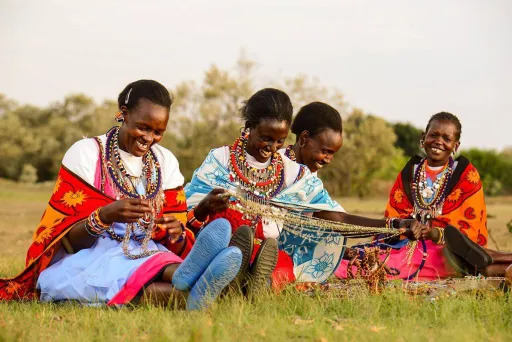
Masai Culture and Traditions
Traditional Masai attire is a vibrant expression of their cultural identity and varies based on age and gender. Women wear metal hoops as part of their adornments, which are often paired with colorful beadwork that signifies social status and personal style. Young men wear black clothing after their circumcision ceremony, marking their transition into warrior status. This attire is typically accompanied by elaborate beadwork and sometimes animal skin, emphasizing their readiness to protect and serve the Maasai community. The clothing and accessories of the Maasai are not just functional but also serve as a reflection of their rich cultural heritage.
Music and Dance
Maasai music is primarily vocal, featuring harmonized singing led by a soloist known as the olaranyani. The music often includes multiple vocal parts that create complex rhythms, primarily performed by groups of male warriors who also engage in synchronized dancing. This vocal tradition is a vibrant aspect of Masai culture, emphasizing community participation and collective harmony.

The Adamu dance, performed by young maasai warriors, involves high jumps and serves as a display of strength and agility. This dance is traditionally performed during ceremonies and is intended to attract potential mates, showcasing the physical prowess of the maasai warrior.
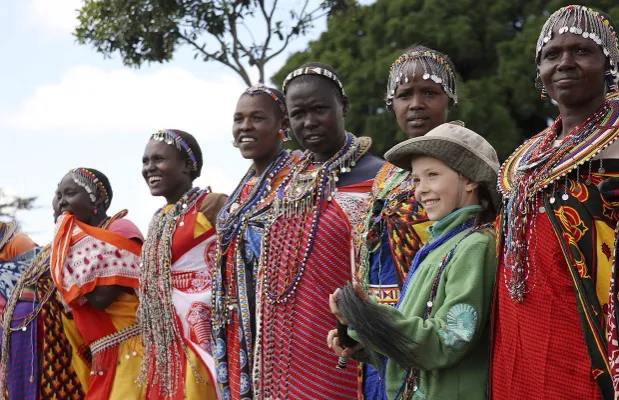
Traditional Maasai Diet
The traditional Masai diet is a reflection of their pastoral lifestyle, heavily reliant on the resources provided by their cattle. Essential components of this diet include meat, milk, and blood, which provide the necessary nutrients for their semi-nomadic way of life. These dietary practices are deeply ingrained in Masai culture, symbolizing their connection to their livestock.
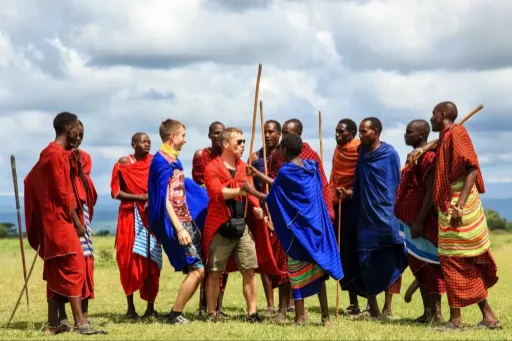
In addition to meat, milk, and blood, the Maasai diet also includes fat, honey, and tree bark, which are gathered from their natural surroundings. This diverse diet not only sustains them physically but also culturally, reinforcing their identity as pastoralists who live in harmony with their environment.
Role of Maasai Women and Men
In Maasai society, gender roles are clearly defined, with men typically taking on roles as warriors and protectors. Elder Maasai men hold significant positions of authority and are responsible for guiding the community and making important decisions. Maasai men, including young warriors, are responsible for herding and protecting the livestock, a crucial aspect of their pastoralist lifestyle. Young boys are groomed from a young age to take on these responsibilities, learning the skills needed to become future protectors of their community. These young warriors also play a significant role in defending the community and participating in cultural rituals.
Before:
Maasai women, on the other hand, are primarily responsible for household tasks, including building and maintaining the traditional Masai houses, known as Inkajijik. They also care for children and manage the daily domestic activities, ensuring the smooth functioning of the family unit. Women recite lullabies to soothe children and pass down cultural stories, enriching the community’s oral traditions. This division of labor highlights the complementary roles that men and women play in sustaining the Maasai way of life.
After:
Masai women are primarily responsible for household tasks, including:
Building and maintaining the traditional Masai houses, known as Inkajijik
Caring for children
Managing daily domestic activities to ensure the smooth functioning of the family unit
Reciting lullabies to children, preserving oral traditions and cultural narratives
This division of labor highlights the complementary roles that men and women play in sustaining the Maasai way of life among the Maasai community.
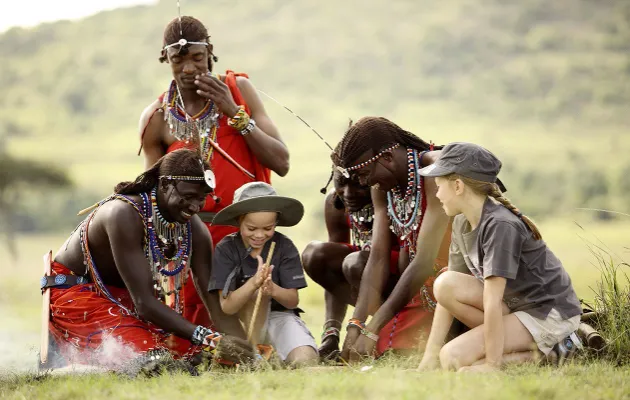
Maasai Shelter and Housing
The traditional huts of the Maasai, known as ‘Manyatta’ or Inkajijik, are examples of unusual and interesting housing. These structures are typically circular or loaf-shaped, constructed from mud, sticks, and cow dung, with cow’s urine added for durability. Built primarily by women, these homes reflect the Maasai community’s semi-nomadic lifestyle, designed to be easily transportable.
Each Maasai village is enclosed by a circular fence, known as Enkang, which serves to protect the livestock from predators during the night. The impermanent nature of these homes signifies the Maasai’s mobility and adaptability to their environment, allowing them to move with their herds in search of grazing land. This unique housing style is a testament to the Maasai’s resourcefulness and their ability to create sustainable living spaces that align with their cultural and environmental needs.
Modern Challenges and Adaptations
In recent decades, the Maasai have faced numerous challenges, including:
The dispossession of fertile lands in Tanzania for agriculture and wildlife reserves
The establishment of national parks, which has further complicated their traditional pastoralist lifestyle
Increased human-wildlife conflict
Restrictions on grazing
As a result, many Maasai have been forced to adapt by seeking new forms of employment, such as farming, business, and wage labor. These changes have been driven by population pressure, cattle loss, and the loss of rangelands, making the traditional nomadic lifestyle increasingly difficult to maintain.
Despite these challenges, the Maasai continue to navigate their way through modern pressures while striving to preserve their cultural heritage.
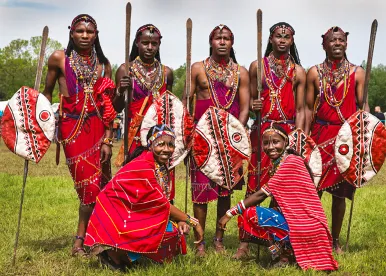
Eviction from Ancestral Land
The Maasai tribe has faced significant challenges regarding their ancestral lands, with many communities at risk of eviction due to tourism and trophy hunting activities. The Tanzanian government has forcibly relocated Maasai tribes populations under the guise of conservation, resulting in reduced access to health services and education, and many have felt as though they have maasai lost their connection to their heritage.
The 2022 eviction events, which saw the use of live ammunition and tear gas against Maasai communities, led to the displacement of more than 150,000 people. International pressure has led to some successes, including halting specific projects that would have evicted thousands of Maasai.
In December 2024, the Tanzanian president met with Maasai leaders, acknowledging past injustices and promising to address land disputes.
Interaction with Wildlife and Tourism
The Maasai’s dependence on cattle has made them vulnerable to conflicts with wild animals, leading to retaliatory killings of predators. Tourism and conservation projects, particularly in areas like Masai Mara, have increasingly taken over traditional grazing lands, providing little economic benefit to the local Maasai communities.
Programs like the Maasai Wilderness Conservation Trust aim to balance traditional lifestyles with wildlife conservation efforts. Indigenous-led ecotourism initiatives have also emerged, empowering the Maasai by providing fair compensation while promoting cultural preservation. However, the commercialization of Masai culture for tourist expectations often strips these traditions of their authentic significance.

Language and Communication
The Maasai language is central to the identity and culture of the Masai people. It serves as a vital link to their heritage, with the term ‘Maasai’ itself deriving from the word for ‘people who maasai speak Maa’. Maa is closely related to the languages of neighboring tribes, highlighting the interconnectedness of the Maasai with other ethnic groups.
The persistence of the Maasai language amid globalization reflects the Maasai’s commitment to preserving their cultural narratives and history.
Maasai Myth and Spiritual Beliefs
The Maasai tribe holds a belief in a supreme deity called Enkai, who is considered the creator of the earth and humanity. According to Maasai mythology, they believe they descended to earth from heaven via a rope. Spiritual leaders, known as Oloiboni or Loibon, possess both mystical and medicinal abilities, playing a crucial role in the community by predicting the future, performing healing, and leading rituals.
Vocal harmony is a crucial element in Maasai music, often performed during ceremonies and social gatherings to convey stories and cultural values. The Maasai language, predominantly oral, serves as a crucial vehicle for passing down cultural narratives and history.
The Maasai also have various legends that shape their cultural narratives, including tales of characters navigating familial relationships and societal expectations.

Summary
The journey through the Maasai’s history, culture, and modern challenges reveals a community deeply rooted in tradition yet adaptable to changing circumstances. From their origins in South Sudan to their current struggles with land dispossession and modern pressures, the Maasai people exemplify resilience and cultural pride. By understanding their rich traditions, including their music, diet, social roles, and spiritual beliefs, we gain a deeper appreciation for this remarkable community. The Maasai’s ability to navigate modern challenges while preserving their cultural heritage is a testament to their enduring spirit. The iconic Masai Mara, a significant part of their territory, serves as a reminder of the deep connection they maintain with their land and wildlife, further highlighting their cultural significance and environmental stewardship.
Frequently Asked Questions
Where did the Maasai people originally migrate from?
The Maasai people originally migrated from South Sudan to their current regions in East Africa.
What are the primary components of the traditional Masai diet?
The traditional Masai diet is primarily composed of meat, milk, and blood from cattle, supplemented by fat, honey, and tree bark. This diet reflects their pastoral lifestyle and reliance on livestock.
How do Masai women contribute to their society?
Masai women play a crucial role in their society by managing household tasks, such as building traditional homes and caring for Maasai children, which sustains family life and cultural practices. Their contributions are essential for the continuity of Masai culture and community organization, ensuring that Maasai children grow up immersed in their rich traditions and values.
What challenges have the Maasai faced due to modern conservation efforts?
The Maasai have experienced considerable difficulties from modern conservation initiatives, such as eviction from their ancestral lands, limited access to health services and education, and heightened human-wildlife conflict. These challenges highlight the need for more inclusive conservation strategies that respect indigenous rights.
What role does the Maa language play in Maasai culture?
The Maa language is fundamental to Maasai identity, as it preserves their heritage and cultural narratives, reinforcing their community’s unique identity and history.
Information About Masai Mara and Conservancy:
Welcome to AjKenya Safaris
Thanks for stopping by! We’re excited to help you plan an unforgettable safari.
- Phone: +254 748 258880
- WhatsApp: +254 748 258880
- Email: [email protected]
- Email: [email protected]




